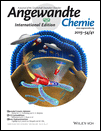Large Magnetization and Frustration Switching of Magnetoresistance in the Double-Perovskite Ferrimagnet Mn2FeReO6
Graphical Abstract
Double-perovskite magnetism: The double perovskite Mn2FeReO6 synthesized at high pressure has magnetic transition-metal cations at all sites. High-spin Mn2+ cations lead to record magnetizations for double-perovskite ferrimagnets and their frustrated magnetic order at 75 K switches magnetoresistance from negative to large positive values at low temperatures.
Abstract
Ferrimagnetic A2BB′O6 double perovskites, such as Sr2FeMoO6, are important spin-polarized conductors. Introducing transition metals at the A-sites offers new possibilities to increase magnetization and tune magnetoresistance. Herein we report a ferrimagnetic double perovskite, Mn2FeReO6, synthesized at high pressure which has a high Curie temperature of 520 K and magnetizations of up to 5.0 μB which greatly exceed those for other double perovskite ferrimagnets. A novel switching transition is discovered at 75 K where magnetoresistance changes from conventional negative tunneling behavior to large positive values, up to 265 % at 7 T and 20 K. Neutron diffraction shows that the switch is driven by magnetic frustration from antiferromagnetic Mn2+ spin ordering which cants Fe3+ and Re5+ spins and reduces spin-polarization. Ferrimagnetic double perovskites based on A-site Mn2+ thus offer new opportunities to enhance magnetization and control magnetoresistance in spintronic materials.





